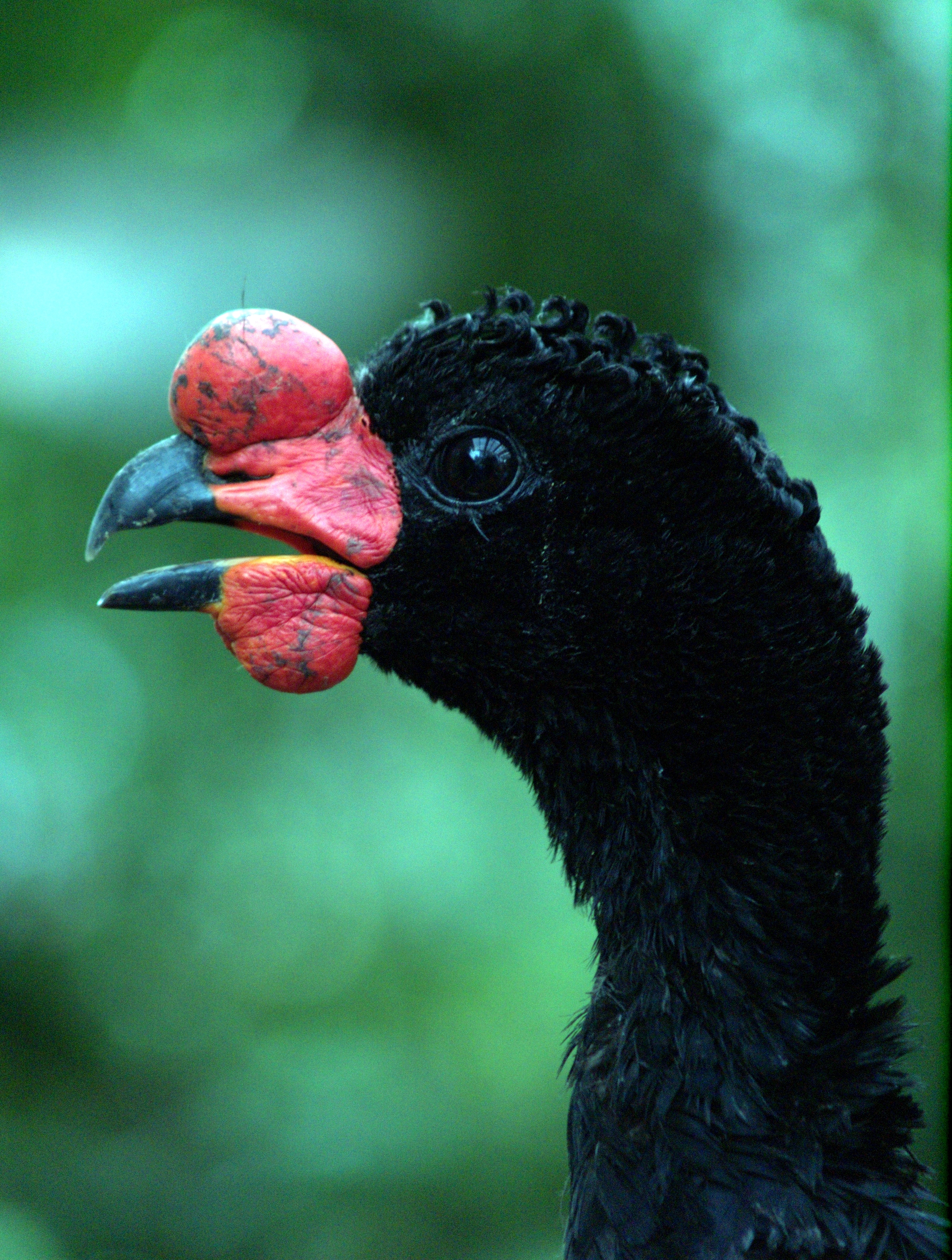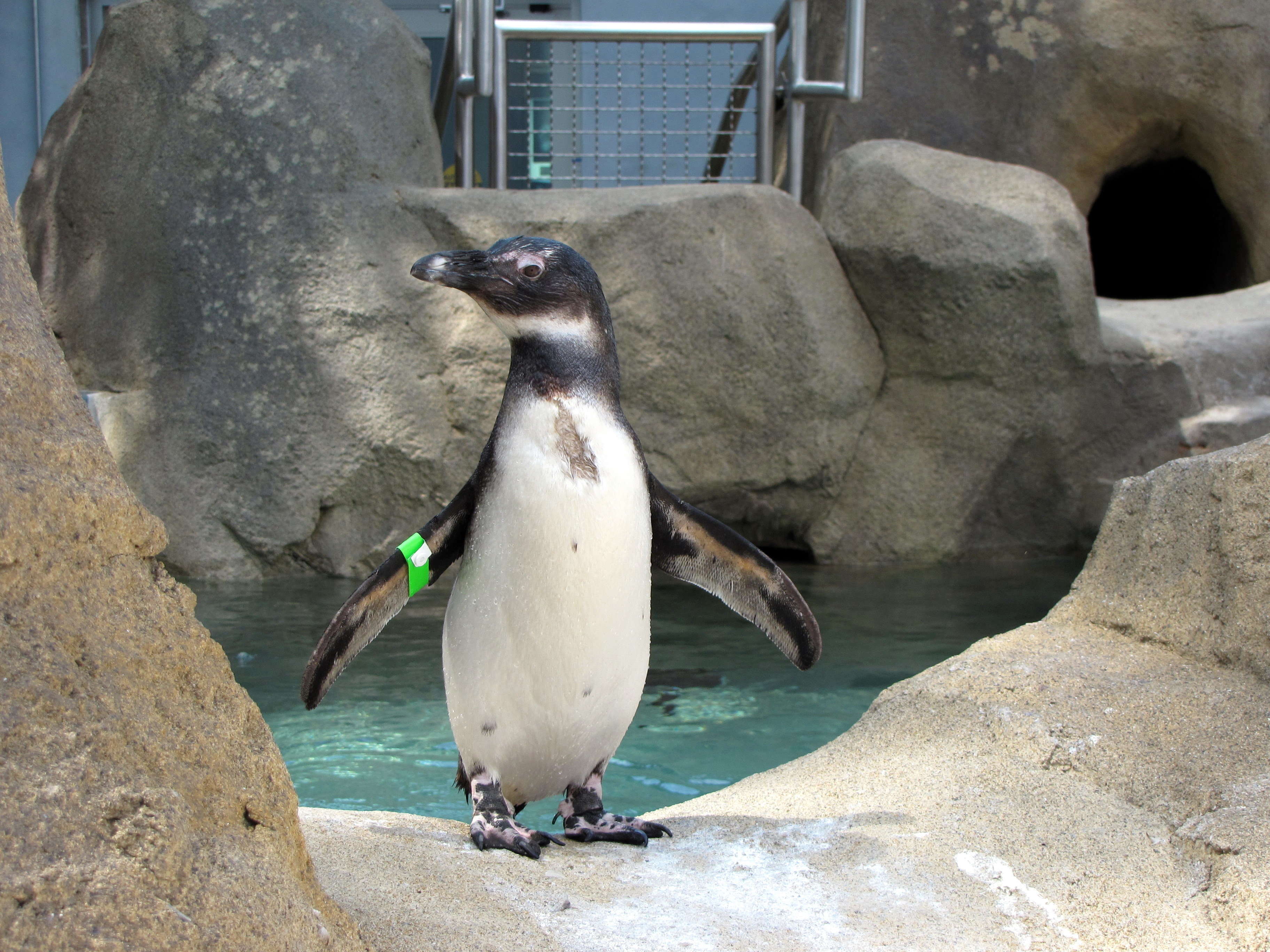|
Crax Globulosa
The wattled curassow (''Crax globulosa'') is a threatened member of the family Cracidae, the curassows, guans, and chachalacas. It is found in remote rainforests in the western Amazon basin in South America. Males have black plumage, except for a white crissum (the area around the cloaca), with curly feathers on the head and red bill ornaments and wattles. Females and juveniles are similar but lack the bill ornamentation and have a reddish-buff crissum area. The wattled curassow is the most ancient lineage of the southern ''Crax'' curassows. In captivity, it sometimes hybridises with the blue-billed curassow. The habitat of the wattled curassow is gallery forests and seasonally-flooded forests where it feeds in small groups on the ground. The diet is largely fruit, but invertebrates and some small vertebrates are opportunistically taken. Little is known of its breeding habits, but it is known that the nest is built of sticks and leaves and two eggs are usually laid. The popula ... [...More Info...] [...Related Items...] OR: [Wikipedia] [Google] [Baidu] |
National Aviary
The National Aviary, located in Pittsburgh, Pennsylvania, Pittsburgh, Pennsylvania, is the only independent indoor nonprofit aviary in the United States. It is also the country's largest aviary, and the only one accorded honorary "National" status by the United States Congress. The aviary is home to more than 500 birds representing more than 150 species, and is a member of the Association of Zoos and Aquariums (AZA). Location and features The National Aviary is located at 700 Arch Street on Pittsburgh, Pennsylvania, Pittsburgh's North Side (Pittsburgh), Northside, within Allegheny Commons West Park, Pittsburgh, West Park in the Allegheny Center (Pittsburgh), Allegheny Center neighborhood. The National Aviary is open daily except Thanksgiving Day, Christmas Eve, and Christmas. Although some of the birds must be fed in private, almost all feedings (both vegetarian and carnivorous) are scheduled to be viewable by visitors. Since 1999, annual attendance has consistently topped 100, ... [...More Info...] [...Related Items...] OR: [Wikipedia] [Google] [Baidu] |
Bird Egg
Bird eggs are laid by the females and range in quantity from one (as in condors) to up to seventeen (the grey partridge). Clutch size may vary latitudinally within a species. Some birds lay eggs even when the eggs have not been fertilized; it is not uncommon for pet owners to find their lone bird nesting on a clutch of infertile eggs, which are sometimes called wind-eggs. Anatomy All bird eggs contain the following components: * The embryo is the immature developing chick * The amnion is a membrane that initially covers the embryo and eventually fills with amniotic fluid, provides the embryo with protection against shock from movement * The allantois helps the embryo obtain oxygen and handles metabolic waste * The chorion, together with the amnion, forms the amniotic sac and encloses the amnion, vitellus, and the embryo * The vitellus, or yolk, is the nutrient-bearing portion of the egg, containing most of its fat, minerals, and many of its proteins and blood vessels * The alb ... [...More Info...] [...Related Items...] OR: [Wikipedia] [Google] [Baidu] |
Down (feather)
The down of birds is a layer of fine feathers found under the tougher exterior feathers. Very young birds are clad only in down. Powder down is a specialized type of down found only in a few groups of birds. Down is a fine thermal insulator and padding, used in goods such as jackets, bedding (duvets and featherbeds), pillows and sleeping bags. The discovery of feathers trapped in ancient amber suggests that some species of dinosaur may have possessed down-like feathers. Description and etymology The word ''down'' comes from the Old Norse word ''dúnn'', which had the same meaning as its modern equivalent. The down feather is considered to be the most "straightforward" of all feather types. It has a short or vestigial rachis (shaft), few barbs, and barbules that lack hooks. There are three types of down: natal down, body down and powder down. Natal down is the layer of down feathers that cover most birds at some point in their early development. Precocial nestlings are alread ... [...More Info...] [...Related Items...] OR: [Wikipedia] [Google] [Baidu] |
Wing Covert
A covert feather or tectrix on a bird is one of a set of feathers, called coverts (or ''tectrices''), which, as the name implies, cover other feathers. The coverts help to smooth airflow over the wings and tail. Ear coverts The ear coverts are small feathers behind the bird's eye which cover the ear opening (the ear of a bird has no external features) Tail coverts The uppertail and undertail coverts cover the base of the tail feathers above and below. Sometimes these coverts are more specialised. The "tail" of a peacock is made of very elongated uppertail coverts. Wing coverts The upperwing coverts fall into two groups: those on the inner wing, which overlay the secondary flight feathers, known as the secondary coverts, and those on the outerwing, which overlay the primary flight feathers, the primary coverts. Within each group, the feathers form a number of rows. The feathers of the outermost, largest, row are termed greater (primary-/secondary-) coverts; those in the next row ... [...More Info...] [...Related Items...] OR: [Wikipedia] [Google] [Baidu] |
Remiges
Flight feathers (''Pennae volatus'') are the long, stiff, asymmetrically shaped, but symmetrically paired pennaceous feathers on the wings or tail of a bird; those on the wings are called remiges (), singular remex (), while those on the tail are called rectrices (), singular rectrix (). The primary function of the flight feathers is to aid in the generation of both thrust and lift, thereby enabling flight. The flight feathers of some birds have evolved to perform additional functions, generally associated with territorial displays, courtship rituals or feeding methods. In some species, these feathers have developed into long showy plumes used in visual courtship displays, while in others they create a sound during display flights. Tiny serrations on the leading edge of their remiges help owls to fly silently (and therefore hunt more successfully), while the extra-stiff rectrices of woodpeckers help them to brace against tree trunks as they hammer on them. Even flightless birds ... [...More Info...] [...Related Items...] OR: [Wikipedia] [Google] [Baidu] |
Wattle (anatomy)
A wattle is a fleshy caruncle hanging from various parts of the head or neck in several groups of birds and mammals. Caruncles in birds include those found on the face, wattles, dewlaps, snoods, and earlobes. Wattles are generally paired structures, but may occur as a single structure when it is sometimes known as a dewlap. Wattles are frequently organs of sexual dimorphism. In some birds, caruncles are erectile tissue and may or may not have a feather covering. Wattles are often such a striking morphological characteristic of animals that it features in their common name. For example, the southern and northern cassowaries are known as the double-wattled and single-wattled cassowary, respectively, and a breed of domestic pig is known as the Red Wattle. Birds Function In birds, wattles are often an ornament for courting potential mates. Large wattles are correlated with high testosterone levels, good nutrition, and the ability to evade predators, which in turn indicates a ... [...More Info...] [...Related Items...] OR: [Wikipedia] [Google] [Baidu] |
Mandible
In anatomy, the mandible, lower jaw or jawbone is the largest, strongest and lowest bone in the human facial skeleton. It forms the lower jaw and holds the lower tooth, teeth in place. The mandible sits beneath the maxilla. It is the only movable bone of the skull (discounting the ossicles of the middle ear). It is connected to the temporal bones by the temporomandibular joints. The bone is formed prenatal development, in the fetus from a fusion of the left and right mandibular prominences, and the point where these sides join, the mandibular symphysis, is still visible as a faint ridge in the midline. Like other symphyses in the body, this is a midline articulation where the bones are joined by fibrocartilage, but this articulation fuses together in early childhood.Illustrated Anatomy of the Head and Neck, Fehrenbach and Herring, Elsevier, 2012, p. 59 The word "mandible" derives from the Latin word ''mandibula'', "jawbone" (literally "one used for chewing"), from ''wikt:mandere ... [...More Info...] [...Related Items...] OR: [Wikipedia] [Google] [Baidu] |
Apical (anatomy)
Standard anatomical terms of location are used to unambiguously describe the anatomy of animals, including humans. The terms, typically derived from Latin or Greek roots, describe something in its standard anatomical position. This position provides a definition of what is at the front ("anterior"), behind ("posterior") and so on. As part of defining and describing terms, the body is described through the use of anatomical planes and anatomical axes. The meaning of terms that are used can change depending on whether an organism is bipedal or quadrupedal. Additionally, for some animals such as invertebrates, some terms may not have any meaning at all; for example, an animal that is radially symmetrical will have no anterior surface, but can still have a description that a part is close to the middle ("proximal") or further from the middle ("distal"). International organisations have determined vocabularies that are often used as standard vocabularies for subdisciplines of anatomy ... [...More Info...] [...Related Items...] OR: [Wikipedia] [Google] [Baidu] |
Cere
The beak, bill, or rostrum is an external anatomical structure found mostly in birds, but also in turtles, non-avian dinosaurs and a few mammals. A beak is used for eating, preening, manipulating objects, killing prey, fighting, probing for food, Courtship#Courtship in the animal kingdom, courtship, and feeding young. The terms ''beak'' and ''Rostrum (anatomy), rostrum'' are also used to refer to a similar mouth part in some ornithischians, pterosaurs, cetaceans, dicynodonts, anuran tadpoles, monotremes (i.e. echidnas and platypuses, which have a beak-like structure), Sirenidae, sirens, Tetraodontidae, pufferfish, billfishes and Cephalopod beak, cephalopods. Although beaks vary significantly in size, shape, color and texture, they share a similar underlying structure. Two bony projections – the upper and lower mandibles – are covered with a thin keratinized layer of epidermis known as the rhamphotheca. In most species, two holes called ''nares'' lead to the respiratory system. ... [...More Info...] [...Related Items...] OR: [Wikipedia] [Google] [Baidu] |
Maxilla
The maxilla (plural: ''maxillae'' ) in vertebrates is the upper fixed (not fixed in Neopterygii) bone of the jaw formed from the fusion of two maxillary bones. In humans, the upper jaw includes the hard palate in the front of the mouth. The two maxillary bones are fused at the intermaxillary suture, forming the anterior nasal spine. This is similar to the mandible (lower jaw), which is also a fusion of two mandibular bones at the mandibular symphysis. The mandible is the movable part of the jaw. Structure In humans, the maxilla consists of: * The body of the maxilla * Four processes ** the zygomatic process ** the frontal process of maxilla ** the alveolar process ** the palatine process * three surfaces – anterior, posterior, medial * the Infraorbital foramen * the maxillary sinus * the incisive foramen Articulations Each maxilla articulates with nine bones: * two of the cranium: the frontal and ethmoid * seven of the face: the nasal, zygomatic, lacrimal, inferior n ... [...More Info...] [...Related Items...] OR: [Wikipedia] [Google] [Baidu] |
Crimson
Crimson is a rich, deep red color, inclining to purple. It originally meant the color of the kermes dye produced from a scale insect, ''Kermes vermilio'', but the name is now sometimes also used as a generic term for slightly bluish-red colors that are between red and rose. It is the national color of Nepal. History Crimson (NR4) is produced using the dried bodies of a scale insect, ''Kermes'', which were gathered commercially in Mediterranean countries, where they live on the kermes oak, and sold throughout Europe. Kermes dyes have been found in burial wrappings in Anglo-Scandinavian York. They fell out of use with the introduction of cochineal, also made from scale insects, because although the dyes were comparable in quality and color intensity, it needed ten to twelve times as much kermes to produce the same effect as cochineal. Carmine is the name given to the dye made from the dried bodies of the female cochineal, although the name crimson is sometimes applied to ... [...More Info...] [...Related Items...] OR: [Wikipedia] [Google] [Baidu] |
Iris (eye)
In humans and most mammals and birds, the iris (plural: ''irides'' or ''irises'') is a thin, annular structure in the eye, responsible for controlling the diameter and size of the pupil, and thus the amount of light reaching the retina. Eye color is defined by the iris. In optical terms, the pupil is the eye's aperture, while the iris is the diaphragm. Structure The iris consists of two layers: the front pigmented fibrovascular layer known as a stroma and, beneath the stroma, pigmented epithelial cells. The stroma is connected to a sphincter muscle (sphincter pupillae), which contracts the pupil in a circular motion, and a set of dilator muscles (dilator pupillae), which pull the iris radially to enlarge the pupil, pulling it in folds. The sphincter pupillae is the opposing muscle of the dilator pupillae. The pupil's diameter, and thus the inner border of the iris, changes size when constricting or dilating. The outer border of the iris does not change size. The constrictin ... [...More Info...] [...Related Items...] OR: [Wikipedia] [Google] [Baidu] |



.jpg)




